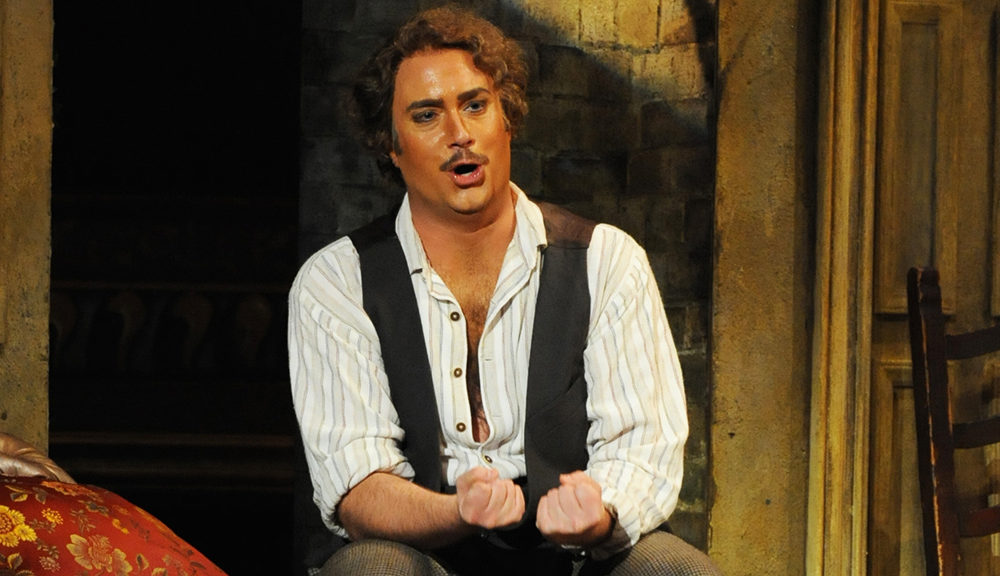
DUSTED OFF, FROM THE TOP SHELF
And an Operatic 1st: a ‘Sex-and-a-half-Tet’
SAN JOSE, CA—Score one with staging Mark Lanz Weiser’s 1998 work “Where Angels Fear to Tread” at Opera San Jose. This was the last of many admirable judgments by OSJ founder (and former mezzo great) Irene Dalis, who pushed mounting the work despite the 31-year record of chancey audience response to new works at OSJ. 15 years had passed since the troupe had mounted any premiere. This may well be judged her crowning production legacy, but she never got to hear it, dying two months short of opening night.
Her judgment was vindicated with this stirring three-act evening shifting from marital bliss to a multiple tragedy, via this neglected opera sitting on the shelf throughout this millennium.
A culture clash of reserved British Victorians confronted by robust Italians is the essence of “Where Angels Fear to Tread,” given its professional mainstage premiere Feb. 7 by Opera San Jose in an elegant, absorbing production. Add it to your short list of recent viable American operas.
E.M. Forster’s 1905 novel has been boiled down to 11 scenes, now entirely in Italy, where the dashing young Gino conquers several English hearts and marries one, Lilia. The other U.K. arrivals take up a custody battle over the resultant baby, showering contempt on all the trans-Alpine citizenry—part of Forster’s familiar criticism harping on arrogance and bias in English society.
Stage Director Lillian Groag injected absorbing characterizations into the six main roles, managing to produce drama despite the enigmatic, waxy British figures springing up from Forster’s pages. She also choreographed the disastrous runaway horse-and-carriage scene without either horse or carriage, just passengers, all kept right before your eyes throughout.
The agreeable tonal music by composer Weiser, 46, is readily assimilated, affectionate to the voice, and amenable to a variety of ensembles, one of them an unprecedented “sex-and-a-half-tet:” Six singers in an uproarious finale, assisted by obbligato howls on cue from a lap dog on stage.
Weiser’s finest music embodies the complex personality of Caroline, whose several arias were to die for as poured out by lyric soprano Christie Conover. But the tenor (Kirk Dougherty) is a wimp who can’t make a move on Caroline, who thinks she loves the Italian Gino (baritone Matthew Hanscom, masterfully capturing
every nuance of gesticulation and expression) but never follows through. The vocal interactions needed a bit more fine-tuning; a true love scene with duet was sorely lacking.
Throughout, the comedy comes from the harridan Harriet (booming-voiced mezzo Lisa Chavez), fuming and fussing while barking orders to the meek. Support comes from the one romantic role, Gino’s wife Lilia (Isabella Ivy), and the “Lucia” coloratura (Jennie Litster) tossing in bits of Donizetti’s opera.
Holding the orchestra to the baton was Music Director Joseph Marcheso, who managed the entr’acte that opens the last scene of act two in that tricky five-four meter. Weiser’s other memorable touches were the heavy tragic outpourings and brass chorales, coloring and underlining the action.
Michael Ganio provided an atmospheric curtain design looking like an old manuscript map of the fictional Italian town of Monteriano, so realistic that you could almost smell the chianti wine spilled on the street corner.
The opera, three hours in length, ran at the 1,100-seat California Theater, small enough to avoid straining the younger voices on the OSJ resident-artists roster.
OSJ called this a world premiere, conveniently overlooking the 1999 performances given at the Peabody Conservatory in Baltimore, where Weiser and the effective librettist Roger Brunyate had served on the faculty.
All six OSJ performances were dedicated to the memory of Miss Dalis, who was the OSJ artistic director 1985-2004.
Weiser’s “Where Angels Fear to Tread” at Opera San Jose. California Theater, San Jose, through Feb. 22. For info: 408.437.4450, or go online.
©Paul Hertelendy 2015
#
Paul Hertelendy has been covering the dance and modern-music scene in the San Francisco Bay Area with relish — and a certain amount of salsa — for years.
These critiques appearing weekly (or sometimes semi-weekly, but never weakly) will focus on dance and new musical creativity in performance, with forays into books (by authors of the region), theater and recordings by local artists as well.
#
Week of Feb. 15-22, 2015
Vol. 17, No. 35